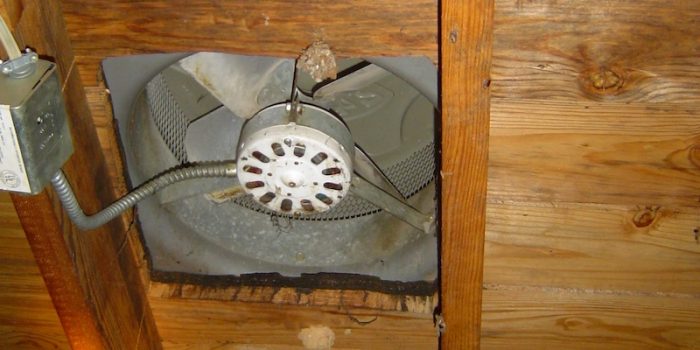
It’s time to revisit one of my favorite topics: the powered attic ventilator. Ten years ago, I wrote an article titled “Don’t Let Your Attic Suck — Power Attic Ventilators Are a Bad Idea.” It has 169 comments and would probably have over 1000 if spammers didn’t force me to close comments on older articles. In 2014, I wrote a followup titled “The #1 Reason Powered Attic Ventilators Don’t Help.” It has 103 comments. Even as old as they are, those two articles have been viewed 15,000 times already this month.
With the recent heat wave in the Pacific Northwest, a lot of people are looking for help with cooling. (If that’s mainly what you’re looking for here, see the Related Articles box below for some good links.) Powered attic ventilators seem to be one option they’re looking at. But I also get questions on this topic from time to time, so today I’ll explore the issue of whether there’s any situation where a powered attic ventilator might be justified.
Recap of powered attic ventilator problems
You can go back and read the previous articles for more details—and the hundreds of comments—but here’s a quick rundown of the problems I described:
- They pull air from wherever they can get it, including conditioned air from the house. Consequently, some of that cooling they provide to the attic is from your air conditioner.
- They can suck moist, moldy air up into the house from a basement or crawlspace.
- They can backdraft a water heater, furnace, or boiler. Backdrafting can lead to incomplete combustion, which can lead to carbon monoxide in the air you breathe.
- They’re a solution to the wrong problem. The heat gets into the attic by radiating down from the hot roof deck. Using a fan to address radiant heating is like thinking you can’t get a sunburn on a breezy day.
Oh, and if your goal is to save money on your cooling bill, they probably won’t do that either.
Questions from readers
Since the earlier articles are closed for comments, I get questions through email and readers filling out the Contact Us form on my website. If you’re not immersed in the world of building science, it can be a confusing issue. You may read through the articles and comments and believe your situation is unique and maybe a powered attic ventilator would be good for your house. Below are some of the questions I’ve received from readers about their situations followed by my answers.
The installers of the new HVAC system told us we “may” need to have a thermostatically controlled exhaust fan installed in order to protect the air handler from excessive heat. It’s June 11th, 92 degrees, and the temperature in the [attic] crawlspace is already well over 100 degrees. May I ask your opinion on this specific instance?
~ Steve W., Pennsylvania
Steve’s HVAC company thinks he needs a powered attic ventilator to protect his air conditioner from attic heat. An unconditioned attic is certainly a bad place to put your heating and cooling system, but a powered attic ventilator will do little to extend its life. I’m not a big fan of radiant barriers because they’re cost effectiveness is marginal, but if an attic air conditioner really needed to be protected from heat, you’d do better to reduce the radiant heat by putting a radiant barrier above the unit. A powered attic ventilator doesn’t address radiant heat and will reduce the attic air temperature only a bit. The air around the AC will still be hot.
What if a second gable fan were installed to draw air from the outside located at the other end of the home opposite of the gable fan that sucks the air out?
~ Carl S., California
Balancing the air flow into and out of the attic is an attempt to eliminate problem #1 above. Even if the two fans are moving equal amounts of air into and out of the attic, though, there’s no guarantee that the exhaust fan isn’t pulling some air from the house and the supply fan isn’t pushing some hot attic air into the house. Air takes the path of least resistance. In addition, more fans means more electricity use.
We do not have AC, so those fans sucking the hard-earned cold air out of the house isn’t an issue. There is no vapor or reflective barrier on the attic ceiling, just wood and nails. During the day our house stays relatively cool with all the windows closed. But come around 7pm until about 11pm it’s hotter inside than out (all windows open now), and from a thermal camera it looks like the attic is dumping stored heat down into the house. Would it be worth it in my case to rig up three (or more) of these fans to three of the attic gables in my 1300-sq.-ft. one-story home?
~ Nate B., Oregon
What Nate really needs is a fan that will do what’s called a night flush. In dry climates—and yes, the air in the Pacific Northwest is dry on warm summer days—flushing the air out of the house with a fan at nighttime brings in cooler outdoor air and is a great way to cool without air conditioning in that kind of climate. Don’t try it in Houston in the summer unless you want to grow mold in the house. To do a night flush, though, you want a whole-house fan, not a powered attic ventilator. You want to cool the house, not the attic. This one by Tamarack (photo below) is a modern version that does a good job and won’t steal heat from the house in winter.
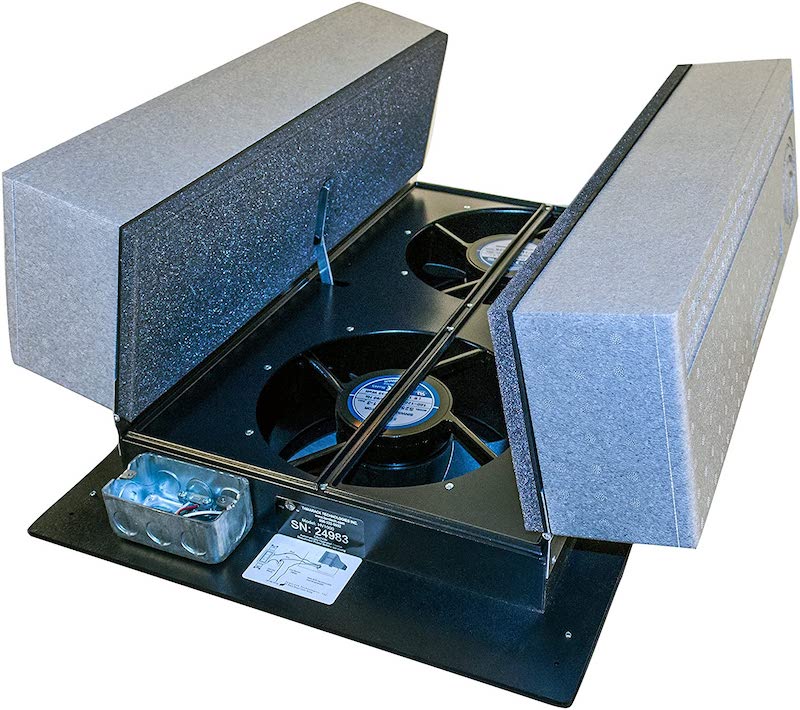
Last week I was replacing some of the screens in the soffit vents and hot air was pouring out of them, and it’s not even summer yet! My immediate thought was to install an attic ventilation fan on each end of the house in the exterior walls under one of the gables that are located on opposite ends of the house (the house is laid out like an “H”). I’m reading the explanations you listed for why attic vents aren’t a good idea, but in this situation I don’t know how else we’d get the hot air out of the attic. We do have insulation in the floor of the attic over the house, but the hot air is trapped up there and it seems like we’d do much better getting it out of there. What are your thoughts?
~ Mark K., Florida
Many people seem to think a hot attic is a bad thing. It’s certainly bad for air conditioners and ducts that might be up there, but it’s OK for an attic to be hot. If that heat is getting into the house, then you need to do more air-sealing and insulating. That applies to poorly sealed and insulated ducts, too. (I just wrote about what you can do for ducts in an unconditioned attic.) Unconditioned attics get hot. It’s a fact. Let it be hot up there. If it’s causing a problem for you down below, there are better solutions than a powered attic ventilator.
The insulation pro is telling me to only add an attic fan (and do not do any additional insulation or touch the old insulation) because adding 14 in. of blown insulation is not going to leave enough space in the attic for air flow. I have tried searching the internet but have not had any luck one way or the other about whether or not too much insulation is a bad thing. And there are mixed reviews about an attic fan being a solution. Your article was very informative but I am left with reservations regarding the best choice given the specifics of my attic. I am hoping you are willing to provide a fellow Gator some advice.
~ Erika M., Florida
The best choice for Erika is not to install a powered attic ventilator. As was the case for your fellow Floridian Mark, it’s OK for the attic to be hot. Also, here’s another idea that’s going to get some readers foaming at the fingers as they type their comments: Even passive attic ventilation doesn’t help much. It doesn’t extend shingle life. It doesn’t save energy in cooling season. It can help with condensation in the attic and ice dams on the roof in cold climates, but Florida doesn’t have that problem.
Is it ever helpful to use a powered attic ventilator?
I’ll admit right up front that powered attic ventilators are helpful for one thing. If you don’t have air conditioning or natural-draft combustion appliances, a powered attic ventilator can keep your attic cooler. I had someone once tell me that the rubber handles on a wheelchair he stored in the attic stopped melting after he installed one.
But for keeping the house cool, a powered attic ventilator isn’t a good idea. To overcome the problems I listed at the beginning of this article, you’d need a situation where the following are true:
- The house doesn’t have air conditioning, or the AC is turned off when the attic ventilator runs.
- The house has no natural-draft water heaters, furnaces, or boilers.
If you don’t have air conditioning, why not just use a whole-house fan to cool the house instead of trying to cool the attic? I read the questions readers send to me on this topic and keep hoping to find a case where I can say, yeah, you really don’t have a better option for keeping your house cool than to put in a powered attic ventilator. I’m still waiting.
____________________________________________________________
Allison Bailes of Atlanta, Georgia, is a speaker, writer, building science consultant, and the founder of Energy Vanguard. He has a PhD in physics and writes the Energy Vanguard Blog. He is also writing a book on building science. You can follow him on Twitter at @EnergyVanguard.
Weekly Newsletter
Get building science and energy efficiency advice, plus special offers, in your inbox.





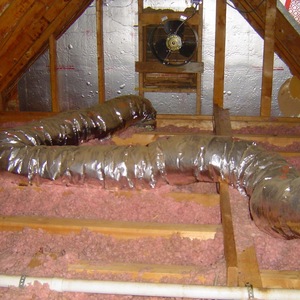
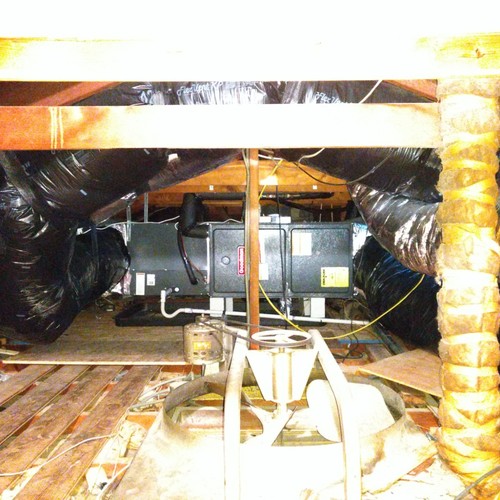

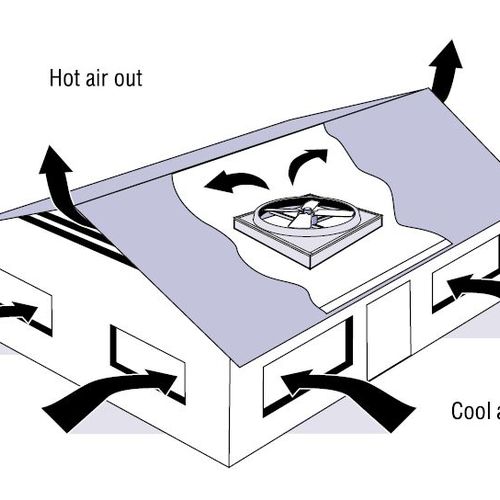






20 Comments
> Recap of powered attic ventilator problems ... They pull air ... keeping your house cool
Apparently your definition of "powered attic ventilator" is the common high CFM (enough to remove significant heat) exhaust ventilation. Most of your statements don't apply to any other forms - so I'd be more specific.
Jon, yes, that's what I'm talking about. That's always how I've seen and heard that term used. I've also written about using an exhaust fan to control humidity in spray foam attics (link below) and always make sure to distinguish between that kind of exhaust fan in attics and the much high air flow rate powered attic ventilators.
https://www.greenbuildingadvisor.com/article/can-an-exhaust-fan-control-humidity-in-a-spray-foam-attic
Maybe you should retitle this "Attic Vent Fans are Evil"
That sounds more like a Green Curmudgeon title, Carl. ;~)
I wish I would have taken notes over the years of people who told me how much these helped their house, it has to be a couple of dozen. The best money they ever spent according to some of them. The psychology of peoples reaction to spending money on energy efficiency measures that have little, no or even negative effect on usage and comfort has always been interesting to me. They can talk themselves into benefits that don't exist to justify the money spent.
Attic fans are interesting in that it it's not something like "Eagle Shield" or replacement windows that are sold because of heavy marketing. I haven't seen an add for attic fans but they still have a strong following.
Is it possible some of them actually meant whole-house fans? That's the only kind of fan in the attic I had ever heard of before reading this. We had one in a house in Worcester, Massachusetts, and it did help a lot (no air conditioning, but between running the whole-house fan for a few minutes at bedtime and then having a ceiling fan going at night, we slept pretty well). I've never lived anywhere in Seattle that they would have been much use (not more than about twice a year anyway), but I know some people's houses get much hotter.
No, they are mostly the 110v whirly bird type vents along with some 110v fans located at gable end vents. Whole house fans are popular here as well but unfortunately, most of them are not the quality of the one shown in the article.
Scott, I've heard those same things. Every time I write about this topic, I get comments to that effect, mostly for the articles posted in the Energy Vanguard Blog, but it's probably happened here, too.
Please tell me this in on LinkedIn so I can share the crap out of it!!
I've shared it there before, but you can easily share it yourself by copying the link to this page and pasting it into a new post on LinkedIn. Easy peasy. Bob's your uncle.
I hate disagreeing with you, because I pretty much agree with everything else you've said on here, and appreciate your content. In some homes, and in certain situations, and attic fan does help.
I had a home in San Antonio, TX. Built in 1983, it had modest ceiling insulation, no basement, and a concrete shingled roof (fancy and expensive for 1983). The top floors would get incredibly hot. When you stood on a ladder and put your hand on the ceiling, the heat radiating down from the ceiling was immense.
I installed foam inserts behind all my light switches, outlets, and caulked all the windows and replaced all my doors with PVC frames and fiberglass doors with dual pane windows. I scraped the popcorn in the ceiling and sealed any areas where the drywall had gaps or cracks. I replaced all my lights with LED, caulked around the HVAC vent to drywall seal (under the aesthetic vents), re-taped all my HVAC ducts in the attic, and replaced my can lights with sealed LED can lights, and did all the other "things." I added additional insulation to the attic where I could get to it. It certainly helped, but the top floor was still incredibly hot. I even increased the HVAC register size on the second floor to encourage more air return from the upstairs. It helped, but didn't make a difference at all for the heat emanating from the ceiling.
I decided to install a thermostatically controlled fan (would turn on at 110+ degrees) at one end of the roof into one of the ridge vents. Basically, it accelerated the natural flow of air as designed originally in the house. It would suck air from the soffits and expel it out the ridge vent. The very day after I did that, the upstairs was easily 10-15 degrees cooler with the rest of the house. I cannot express enough how much difference it made. I can totally understand how in every other situation this would do as you say, but I insist in cases where you are literally working with the natural design of the home, it will help. I'd been averaging the cost of electricity month to month for almost 3 years, and I noticed a slight increase in power consumption from the fan (it would turn on around 5:00 in the afternoon and then wouldn't turn off until something like 2 in the morning). But the home was much cooler, and the HVAC system no longer ran continuously.
> a powered attic ventilator ... house has no natural-draft water heaters, furnaces, or boilers.
> why not just use a whole-house fan to cool the house
From experience with both, the whole-house attic fan reversed interior natural drafts (a big problem) and the high CFM attic exhaust fan had no noticeable effect on them. This isn't surprising - the latter pulls most of its air from attic intake vents and only a little from the house interior.
A number of years ago I conducted an attic venting study here in California for the state and a couple utilities. We measured and monitored attic temperatures in different areas around the state and tried different venting strategies. What we found was a lot hot air, powered air vents and other attic vents did little to cool attics. Here in the Central Valley of California attic temperatures regularly hit 180 degrees or higher in the summer months. Vents had a local affect but overall had no effect on the temperature of an attic or reducing the heat load on a house. A couple homes we monitored for the entire summer blocking and unblocking the vents to no real effect on cooling the attic. The biggest factors for attic temperatures are the roofing materials - asphalt shingles are the No. 1 cause of high attic temperatures. The Sun heats them up to around 200 degrees or more and all that heat is transferred into the attic. It is basically black topping the roof of your house. Comp shingle manufacturers void warranties if the attic isn’t vented to code (you don’t want to know how attic venting standards were adopted) because they say the attic will get too hot. The reason the attic gets too hot is their shingles! Attic temps drop off quickly when the gets shaded (we looked at shading from trees). Want to reduce your attic temps then reroof with a heat reflecting type of shingle or cement or ceramic shingles (wood is great too but a fire hazard). We also measured temperatures on top of insulation, in the middle of the insulation, under the insulation, and on the ceiling in the interior. Very little heat flows into a house from a well insulated attic, even with a 120 delta T between the attic and interior. Duct work is the biggest loser in a hot attic because of its low levels of insulation. Powered attic vents and regular vents can depressurize an attic and draw cool house air into the attic which is likely the cooling effect people report. Roof vents actually cause moisture issues in attics. Whole house fans are a better way to flush out an attic, but that isn’t going to do much to reduce heat loading from an attic if the ceiling is insulated. The findings were pretty much opposite to what I thought going into the study.
Thomas,
Thanks for your very valuable comments. As I wrote in my 2013 article, "All About Attic Venting," "If a house has insulation on the attic floor, there isn’t any evidence to support the idea that attic ventilation will reduce your air conditioning bills."
I also quoted researcher Jeff Gordon, who wrote, “Cooling season energy savings? Well, we tried to measure energy use, but this did not work very well. … Basically, [any savings are] lost in the noise. ... Attic ventilation is not an effective energy conservation procedure for houses with more than 6.5 inches of attic insulation. ... The difference in attic temperature between a vented an unvented attic, with R-30 at the ceiling, translates into minuscule [cooling energy] savings. No savings have ever been measured."
Do you have a link to the report by any chance? Thanks!
The house I live in now is well insulated, and has lots of shade, plus an attic fan would be counter-intuitive to the design of the roof (Florida). But your research is totally opposite of my results in San Antonio Texas (see post just above yours). I did everything, had insulation, etc... but until I installed an attic fan, my HVAC ran constantly... never turned off. After the attic fan, my whole second floor dropped 10-15 degrees the very next day. I want to agree with these comments, but they simply do not jive with my lying eyes and ears. I even have a thermal camera... the difference was astounding.
73vwTodd - does this mean you really sealed the attic?? "added additional insulation to the attic where I could get to it". I'd have to see your thermal images along with blower door test to see how much air sealing you did between walls and attic. Yes, you sealed windows, doors and "cracks" but most of air air leakage we find is within the interior. You could still be sucking cooler conditioned air into the attic for that cool down.
Hi Paul, understand. I no longer own the home (moved due to work about 7 months ago). But here is an itemized list that I performed (note, I totally renovated the entire house):
1 - Removed all the baseboards in every single room. Carpeting upstairs tile throughout downstairs. In the downstairs, I caulked the tile to the baseboard, and the baseboard to the drywall.
2 - Un-"hung" almost every door, and reframed to move doors and / or change direction of swing. Used expanding foam between gaps (even inside) and in headers. Caulked both to trim and door and trim to wall (and floor).
3 - Every crack or hole found in the drywall and / or ceiling that I found, I used caulking, not just more drywall.
4 - Every ceiling fixture was either replaced, or removed, cleaned, and I installed a foam gasket in both the box, and / or around the opening and light fixture. I replaced all the recessed cans with "sealed" LED cans.
5 - Replaced attic access door with a pull-down sealed door that locks.
6 - Removed every single register and HVAC vent, used expanding foam around where the duct attached to the drywall... cut it smooth, and then caulked over it. Then cleaned and replaced the registers to the newer styles, and even used caulking in the holes where I installed the screw in the drywall.
7 - Every outlet and switch-plate was removed and replaced with Decora, and upgraded to GFI where needed for code. I used foam gaskets in all of them.
8 - Sealed all the windows inside and out.
9 - Replaced ALL exterior doors. For the garage to house door, I replaced with a steel foam core door per code, heat / fire rated for garages. For the two exterior doors in the back, I replaced the framing with PVC, and hung fiberglass foam core doors with double-pane windows (w/ inert gas and built in shades). Front door was replaced with a solid mahogany door that came with new seals and framing. Of course, expanding foam everywhere.
10 - Replaced the three bathroom exhaust fans, used expanding foam to seal them to the drywall... goal of course was to improve sealing when shut down. Installed all new exhaust venting to port to the eves, and not into the attic (two were doing that).
11 - My stove had a down-draft and an updraft vent. Taped and sealed the vent tube with the correct heat-appropriate tape and ensured both were properly ducted to the outside, and not dumping into the attic.
12 - Replaced the dryer vent hook-up with a newer one, ensured it was taped with aluminum tape.
13 - Sealed up the HVAC system like you wouldn't believe. Increased the return register size for the second floor, and sealed the duct to ceiling, and used the smoke test to look for leaks. I also taped and/or replaced all of the ducting in the attic.
14 - The home already had about 4"s of insulation... some old Pink Panther crap... and added more "blow in" insulation to add at least another 2 layers and fill in gaps. There were areas I couldn't get to, without removing part of the roof and blowing it in.
My house has this ultra-expensive concrete 50-year tile... not barrel tile, but tile slate. I used Spray & Forget to get the algae off, and replaced about 70% of the fascia boards, as well as replacing all of the flashing. I also had the original company that installed the tile when new (found them) remove and replace roof sheething, and then reinstall all of the tile. I did 100s of other things that I can't think of right now. It all helped, don't get me wrong... it really helped. But the HVAC system, an R22 TRANE 14 SEER system that still ran amazing. I'm HVAC certified (EPA certification). It's not my job, I just did it so I could legally buy freon (as well as R12 for old cars). I'm an engineer (software engineer) / cyber security engineer, and a year away from a law degree. None of that has anything to do with construction or thermal dynamics... so I am totally open to being wrong, but with everything I did, the HVAC system still continued to run all day long, and the ceiling was just radiating heat like you wouldn't believe. My daughter slept upstairs on a raised bed (that had a desk under it) and she couldn't sleep... it was way too hot. The weekend I installed a thermostatically controlled attic fan, the very next day... the temperatures dropped 10-15 degrees upstairs... night and day difference. The HVAC system would actually turn off... and no longer ran continuously. We eventually ended up having to raise the thermostat at night because all of us in the house were starting to get too cold. The attic fan would turn on anywhere from 4:30 to 5:00 PM, and would be off by the time I got up in the morning at 5:00 AM. The longest I ever saw it run was to 2:00 AM on a really hot day, but normally it would have shut off by midnight.
You seem to be addressing a very specific, but important issue regarding powered attic vents. People installing them for the wrong reason. i.e. to cool down their house. I would agree, this is not what powered attic vents are designed to do and they should not be used for that purpose because of the issues you present.
However, when used for their designed purpose - reducing heat in the attic to prevent the premature deterioration of your roof - they are a valid option, so long as they are installed correctly and in concert with the proper amount of intake ventilation. The problems you outlined only occur when an appropriate amount of intake ventilation is not provided and/or the powered vents are oversized for the space. Additionally, a vapor barrier of some sort must be installed (kraft paper backed batt insulation, with the paper side down) between the ceiling joists and your attic flooring (if present). That will help reduce any draw from the interior of the home itself.
It's true, you cannot block the sun from scorching your asphalt shingle roof from above. And shingles are designed to withstand that direct abuse. However, allowing excess heat to accumulate in your attic adds additional heat stress from below, which can warp your decking material and contribute to unnecessary shingle deterioration.
In short - DO NOT use powered attic vents if the goal is to cool your home. DO consider as a potential option for prolonging the life of your roof, provided they're installed correctly.
richcb220,
"Additionally, a vapor barrier of some sort must be installed (kraft paper backed batt insulation, with the paper side down) between the ceiling joists and your attic flooring (if present). That will help reduce any draw from the interior of the home itself.
The problem isn't vapour diffusion caused by the fan, it's air-leakage. So unfortunately a vapour-barrier won't help at all.
You may also find this article interesting: https://www.greenbuildingadvisor.com/article/insulated-rooflines-and-shingle-temperatures
We recently replaced a gravel covered torch down roof with a black EPDM roof in the PNW about 1.5 years ago. The house is a 1 story slab on grade (mostly) early 1950s home with a very low attic (crawl space height) over one portion of the house and ceiling finish over rafters (no attic) in the other portions. The roof is low slope and is vented with 2" soffit vents all around and gable end vents (no ridge vent). The venting area exceeds code requirements but is weighted towards more area at the soffit vents than the gable ends. Here is the problem: On warm sunny days there is a noticeable odor on the lee sides of the house outside that is obviously from the EPDM roof, the bigger issue is that occasionally when the house is closed up during a sunny warm day, we notice some roof odor inside the home but not every time this occurs. This is obviously a concern and we have been considering a number or remedies: change the roof color to a light color(paint the roof w Firestone roof coating for EPDM) with the idea of reducing the roof temperature enough to stop the odor, or use a attic ventilation fan on the attic portion of the roof to change the air during sunny days so that the air does not enter the house. In our case it seems it would be beneficial to not allow air to enter the home from the rafter spaces or attic by negatively pressurizing the attic but I am also concerned about the possibility of introducing some moist air from the interior of the house into the roof spaces where condensation could occur when the temperature drops at night. We would not run the fan on cloudy days or in colder weather since there is no odor issue then. Any thoughts or suggestions would be welcome.
Log in or create an account to post a comment.
Sign up Log in